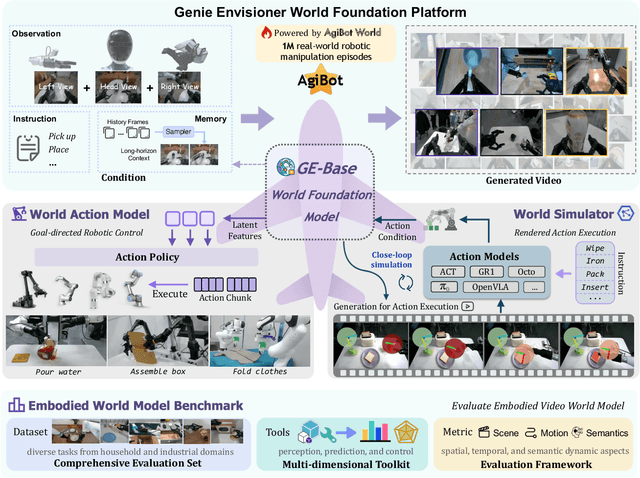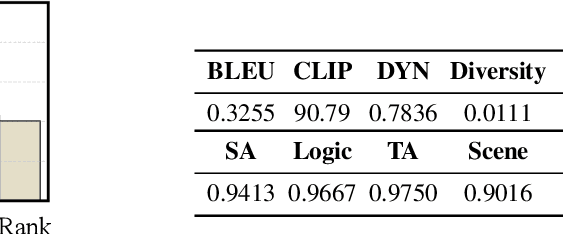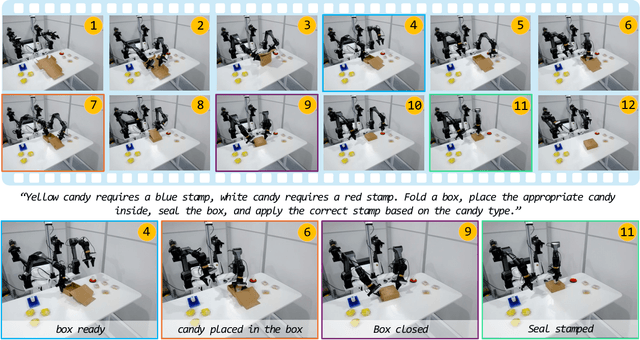Si Liu
Towards Realistic Earth-Observation Constellation Scheduling: Benchmark and Methodology
Oct 30, 2025Abstract:Agile Earth Observation Satellites (AEOSs) constellations offer unprecedented flexibility for monitoring the Earth's surface, but their scheduling remains challenging under large-scale scenarios, dynamic environments, and stringent constraints. Existing methods often simplify these complexities, limiting their real-world performance. We address this gap with a unified framework integrating a standardized benchmark suite and a novel scheduling model. Our benchmark suite, AEOS-Bench, contains $3,907$ finely tuned satellite assets and $16,410$ scenarios. Each scenario features $1$ to $50$ satellites and $50$ to $300$ imaging tasks. These scenarios are generated via a high-fidelity simulation platform, ensuring realistic satellite behavior such as orbital dynamics and resource constraints. Ground truth scheduling annotations are provided for each scenario. To our knowledge, AEOS-Bench is the first large-scale benchmark suite tailored for realistic constellation scheduling. Building upon this benchmark, we introduce AEOS-Former, a Transformer-based scheduling model that incorporates a constraint-aware attention mechanism. A dedicated internal constraint module explicitly models the physical and operational limits of each satellite. Through simulation-based iterative learning, AEOS-Former adapts to diverse scenarios, offering a robust solution for AEOS constellation scheduling. Experimental results demonstrate that AEOS-Former outperforms baseline models in task completion and energy efficiency, with ablation studies highlighting the contribution of each component. Code and data are provided in https://github.com/buaa-colalab/AEOSBench.
MathCanvas: Intrinsic Visual Chain-of-Thought for Multimodal Mathematical Reasoning
Oct 16, 2025Abstract:While Large Language Models (LLMs) have excelled in textual reasoning, they struggle with mathematical domains like geometry that intrinsically rely on visual aids. Existing approaches to Visual Chain-of-Thought (VCoT) are often limited by rigid external tools or fail to generate the high-fidelity, strategically-timed diagrams necessary for complex problem-solving. To bridge this gap, we introduce MathCanvas, a comprehensive framework designed to endow unified Large Multimodal Models (LMMs) with intrinsic VCoT capabilities for mathematics. Our approach consists of two phases. First, a Visual Manipulation stage pre-trains the model on a novel 15.2M-pair corpus, comprising 10M caption-to-diagram pairs (MathCanvas-Imagen) and 5.2M step-by-step editing trajectories (MathCanvas-Edit), to master diagram generation and editing. Second, a Strategic Visual-Aided Reasoning stage fine-tunes the model on MathCanvas-Instruct, a new 219K-example dataset of interleaved visual-textual reasoning paths, teaching it when and how to leverage visual aids. To facilitate rigorous evaluation, we introduce MathCanvas-Bench, a challenging benchmark with 3K problems that require models to produce interleaved visual-textual solutions. Our model, BAGEL-Canvas, trained under this framework, achieves an 86% relative improvement over strong LMM baselines on MathCanvas-Bench, demonstrating excellent generalization to other public math benchmarks. Our work provides a complete toolkit-framework, datasets, and benchmark-to unlock complex, human-like visual-aided reasoning in LMMs. Project Page: https://mathcanvas.github.io/
Factuality Matters: When Image Generation and Editing Meet Structured Visuals
Oct 06, 2025Abstract:While modern visual generation models excel at creating aesthetically pleasing natural images, they struggle with producing or editing structured visuals like charts, diagrams, and mathematical figures, which demand composition planning, text rendering, and multimodal reasoning for factual fidelity. To address this, we present the first comprehensive, systematic investigation of this domain, encompassing data construction, model training, and an evaluation benchmark. First, we construct a large-scale dataset of 1.3 million high-quality structured image pairs derived from executable drawing programs and augmented with chain-of-thought reasoning annotations. Building on it, we train a unified model that integrates a VLM with FLUX.1 Kontext via a lightweight connector for enhanced multimodal understanding. A three-stage training curriculum enables progressive feature alignment, knowledge infusion, and reasoning-augmented generation, further boosted by an external reasoner at inference time. Finally, we introduce StructBench, a novel benchmark for generation and editing with over 1,700 challenging instances, and an accompanying evaluation metric, StructScore, which employs a multi-round Q\&A protocol to assess fine-grained factual accuracy. Evaluations of 15 models reveal that even leading closed-source systems remain far from satisfactory. Our model attains strong editing performance, and inference-time reasoning yields consistent gains across diverse architectures. By releasing the dataset, model, and benchmark, we aim to advance unified multimodal foundations for structured visuals.
FLUX-Reason-6M & PRISM-Bench: A Million-Scale Text-to-Image Reasoning Dataset and Comprehensive Benchmark
Sep 11, 2025Abstract:The advancement of open-source text-to-image (T2I) models has been hindered by the absence of large-scale, reasoning-focused datasets and comprehensive evaluation benchmarks, resulting in a performance gap compared to leading closed-source systems. To address this challenge, We introduce FLUX-Reason-6M and PRISM-Bench (Precise and Robust Image Synthesis Measurement Benchmark). FLUX-Reason-6M is a massive dataset consisting of 6 million high-quality FLUX-generated images and 20 million bilingual (English and Chinese) descriptions specifically designed to teach complex reasoning. The image are organized according to six key characteristics: Imagination, Entity, Text rendering, Style, Affection, and Composition, and design explicit Generation Chain-of-Thought (GCoT) to provide detailed breakdowns of image generation steps. The whole data curation takes 15,000 A100 GPU days, providing the community with a resource previously unattainable outside of large industrial labs. PRISM-Bench offers a novel evaluation standard with seven distinct tracks, including a formidable Long Text challenge using GCoT. Through carefully designed prompts, it utilizes advanced vision-language models for nuanced human-aligned assessment of prompt-image alignment and image aesthetics. Our extensive evaluation of 19 leading models on PRISM-Bench reveals critical performance gaps and highlights specific areas requiring improvement. Our dataset, benchmark, and evaluation code are released to catalyze the next wave of reasoning-oriented T2I generation. Project page: https://flux-reason-6m.github.io/ .
AeroDuo: Aerial Duo for UAV-based Vision and Language Navigation
Aug 21, 2025Abstract:Aerial Vision-and-Language Navigation (VLN) is an emerging task that enables Unmanned Aerial Vehicles (UAVs) to navigate outdoor environments using natural language instructions and visual cues. However, due to the extended trajectories and complex maneuverability of UAVs, achieving reliable UAV-VLN performance is challenging and often requires human intervention or overly detailed instructions. To harness the advantages of UAVs' high mobility, which could provide multi-grained perspectives, while maintaining a manageable motion space for learning, we introduce a novel task called Dual-Altitude UAV Collaborative VLN (DuAl-VLN). In this task, two UAVs operate at distinct altitudes: a high-altitude UAV responsible for broad environmental reasoning, and a low-altitude UAV tasked with precise navigation. To support the training and evaluation of the DuAl-VLN, we construct the HaL-13k, a dataset comprising 13,838 collaborative high-low UAV demonstration trajectories, each paired with target-oriented language instructions. This dataset includes both unseen maps and an unseen object validation set to systematically evaluate the model's generalization capabilities across novel environments and unfamiliar targets. To consolidate their complementary strengths, we propose a dual-UAV collaborative VLN framework, AeroDuo, where the high-altitude UAV integrates a multimodal large language model (Pilot-LLM) for target reasoning, while the low-altitude UAV employs a lightweight multi-stage policy for navigation and target grounding. The two UAVs work collaboratively and only exchange minimal coordinate information to ensure efficiency.
Genie Envisioner: A Unified World Foundation Platform for Robotic Manipulation
Aug 07, 2025



Abstract:We introduce Genie Envisioner (GE), a unified world foundation platform for robotic manipulation that integrates policy learning, evaluation, and simulation within a single video-generative framework. At its core, GE-Base is a large-scale, instruction-conditioned video diffusion model that captures the spatial, temporal, and semantic dynamics of real-world robotic interactions in a structured latent space. Built upon this foundation, GE-Act maps latent representations to executable action trajectories through a lightweight, flow-matching decoder, enabling precise and generalizable policy inference across diverse embodiments with minimal supervision. To support scalable evaluation and training, GE-Sim serves as an action-conditioned neural simulator, producing high-fidelity rollouts for closed-loop policy development. The platform is further equipped with EWMBench, a standardized benchmark suite measuring visual fidelity, physical consistency, and instruction-action alignment. Together, these components establish Genie Envisioner as a scalable and practical foundation for instruction-driven, general-purpose embodied intelligence. All code, models, and benchmarks will be released publicly.
DOMR: Establishing Cross-View Segmentation via Dense Object Matching
Aug 06, 2025Abstract:Cross-view object correspondence involves matching objects between egocentric (first-person) and exocentric (third-person) views. It is a critical yet challenging task for visual understanding. In this work, we propose the Dense Object Matching and Refinement (DOMR) framework to establish dense object correspondences across views. The framework centers around the Dense Object Matcher (DOM) module, which jointly models multiple objects. Unlike methods that directly match individual object masks to image features, DOM leverages both positional and semantic relationships among objects to find correspondences. DOM integrates a proposal generation module with a dense matching module that jointly encodes visual, spatial, and semantic cues, explicitly constructing inter-object relationships to achieve dense matching among objects. Furthermore, we combine DOM with a mask refinement head designed to improve the completeness and accuracy of the predicted masks, forming the complete DOMR framework. Extensive evaluations on the Ego-Exo4D benchmark demonstrate that our approach achieves state-of-the-art performance with a mean IoU of 49.7% on Ego$\to$Exo and 55.2% on Exo$\to$Ego. These results outperform those of previous methods by 5.8% and 4.3%, respectively, validating the effectiveness of our integrated approach for cross-view understanding.
CoST: Efficient Collaborative Perception From Unified Spatiotemporal Perspective
Aug 01, 2025Abstract:Collaborative perception shares information among different agents and helps solving problems that individual agents may face, e.g., occlusions and small sensing range. Prior methods usually separate the multi-agent fusion and multi-time fusion into two consecutive steps. In contrast, this paper proposes an efficient collaborative perception that aggregates the observations from different agents (space) and different times into a unified spatio-temporal space simultanesouly. The unified spatio-temporal space brings two benefits, i.e., efficient feature transmission and superior feature fusion. 1) Efficient feature transmission: each static object yields a single observation in the spatial temporal space, and thus only requires transmission only once (whereas prior methods re-transmit all the object features multiple times). 2) superior feature fusion: merging the multi-agent and multi-time fusion into a unified spatial-temporal aggregation enables a more holistic perspective, thereby enhancing perception performance in challenging scenarios. Consequently, our Collaborative perception with Spatio-temporal Transformer (CoST) gains improvement in both efficiency and accuracy. Notably, CoST is not tied to any specific method and is compatible with a majority of previous methods, enhancing their accuracy while reducing the transmission bandwidth.
OctoNav: Towards Generalist Embodied Navigation
Jun 11, 2025Abstract:Embodied navigation stands as a foundation pillar within the broader pursuit of embodied AI. However, previous navigation research is divided into different tasks/capabilities, e.g., ObjNav, ImgNav and VLN, where they differ in task objectives and modalities, making datasets and methods are designed individually. In this work, we take steps toward generalist navigation agents, which can follow free-form instructions that include arbitrary compounds of multi-modal and multi-capability. To achieve this, we propose a large-scale benchmark and corresponding method, termed OctoNav-Bench and OctoNav-R1. Specifically, OctoNav-Bench features continuous environments and is constructed via a designed annotation pipeline. We thoroughly craft instruction-trajectory pairs, where instructions are diverse in free-form with arbitrary modality and capability. Also, we construct a Think-Before-Action (TBA-CoT) dataset within OctoNav-Bench to provide the thinking process behind actions. For OctoNav-R1, we build it upon MLLMs and adapt it to a VLA-type model, which can produce low-level actions solely based on 2D visual observations. Moreover, we design a Hybrid Training Paradigm (HTP) that consists of three stages, i.e., Action-/TBA-SFT, Nav-GPRO, and Online RL stages. Each stage contains specifically designed learning policies and rewards. Importantly, for TBA-SFT and Nav-GRPO designs, we are inspired by the OpenAI-o1 and DeepSeek-R1, which show impressive reasoning ability via thinking-before-answer. Thus, we aim to investigate how to achieve thinking-before-action in the embodied navigation field, to improve model's reasoning ability toward generalists. Specifically, we propose TBA-SFT to utilize the TBA-CoT dataset to fine-tune the model as a cold-start phrase and then leverage Nav-GPRO to improve its thinking ability. Finally, OctoNav-R1 shows superior performance compared with previous methods.
RoboCerebra: A Large-scale Benchmark for Long-horizon Robotic Manipulation Evaluation
Jun 07, 2025Abstract:Recent advances in vision-language models (VLMs) have enabled instruction-conditioned robotic systems with improved generalization. However, most existing work focuses on reactive System 1 policies, underutilizing VLMs' strengths in semantic reasoning and long-horizon planning. These System 2 capabilities-characterized by deliberative, goal-directed thinking-remain under explored due to the limited temporal scale and structural complexity of current benchmarks. To address this gap, we introduce RoboCerebra, a benchmark for evaluating high-level reasoning in long-horizon robotic manipulation. RoboCerebra includes: (1) a large-scale simulation dataset with extended task horizons and diverse subtask sequences in household environments; (2) a hierarchical framework combining a high-level VLM planner with a low-level vision-language-action (VLA) controller; and (3) an evaluation protocol targeting planning, reflection, and memory through structured System 1-System 2 interaction. The dataset is constructed via a top-down pipeline, where GPT generates task instructions and decomposes them into subtask sequences. Human operators execute the subtasks in simulation, yielding high-quality trajectories with dynamic object variations. Compared to prior benchmarks, RoboCerebra features significantly longer action sequences and denser annotations. We further benchmark state-of-the-art VLMs as System 2 modules and analyze their performance across key cognitive dimensions, advancing the development of more capable and generalizable robotic planners.
 Add to Chrome
Add to Chrome Add to Firefox
Add to Firefox Add to Edge
Add to Edge